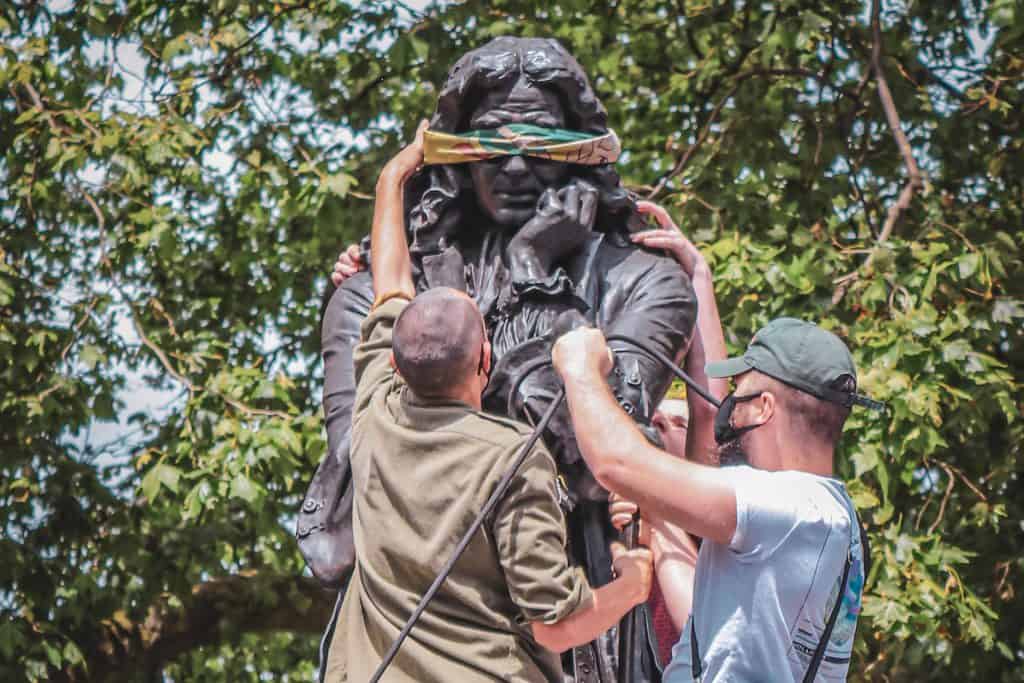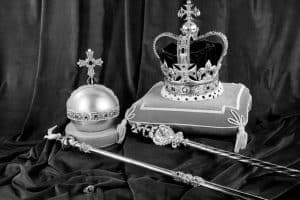Comment by Diarmaid MacCulloch
I will lay my cards on the table straight away; I was hugely cheered to watch the clip of Edward Colston’s statue being chucked in the Avon in the middle of one of my favourite British cities. I frequently passed him during my 17 years living in Bristol, and I have to say that at the time I never gave Colston (1636-1721) much of a thought, apart from the vague knowledge that he was a city benefactor, and that his name was all over the place.
Now, having been educated better, I know better: that his money was made in a pioneering enterprise of the Bristol slave trade; this statue had been put up only in 1895; that it was unpopular from the start and that the public appeal for it failed, so that the instigator ended up mostly paying for it himself; that Colston had been adopted as part of a Victorian campaign to glorify the city’s mercantile past and present, with careful lack of attention to the slavery element in all that glorious wealth.
The Victorian inscriptions on Colston’s monument are nauseating in their praise of him, once you notice the deafening silence in the information they convey. In recent years, all this correction of history has led to a sustained agitation in Bristol to have Colston’s image removed from this honoured public place, and it is in the face of continued hand-wringing and inertia on the part of city authorities that direct action has led, in the words of a deliciously savage (if temporary) interpolation of wit in his Wikipedia entry, to his winning “the inaugural Bristol diving championship of 2020 with a well-received forward tumble, scoring 8.8 points”.
I felt the same sense of justice done when a day or so later, I saw the burning of a statue of King Leopold II of the Belgians in Antwerp, and the subsequent removal of the charred remains by the local authorities. Few single actions have done more than this to stimulate a proper discussion in Belgium of Leopold’s criminal activities in the Congo, subsequently entangling that hitherto relatively blameless kingdom in a century and more of catastrophes in central Africa.
Likewise, the dethronement of a host of Confederate statues in the southern states of America has been inspiring to watch. I read the Facebook lament of one Southern lady that her history was being taken away from her in the demolitions. I was too polite to riposte to a stranger, but should have said: “No, Madam, it isn’t your history being taken away from you, but the lies you were told as a little girl, while your comfort zone was bounded by statues deliberately erected in the Jim Crow era to intimidate black people and celebrate the stealing of their political rights from them by the resurgent Confederate elite. Up till now you have never been given the resources to challenge those lies; now you have.”
Beyond these examples, I read a great deal of why-oh-why lamentation: where will it all end, goes up the cry? You can’t wipe out the past. What about John Newton, who wrote How Sweet the Name of Jesus Sounds while still involved in all the sadism and exploitation of the slave trade? What about Elizabeth I, who financed Drake in his voyages that involved enslaving people? What about Edward I, who expelled all the Jews from England? What about St Paul, who clearly had no problem with the institution of slavery?
Yes, in each case there are historical arguments to be had, and in the end, pragmatic decisions to be made on the basis of a wider understanding of the history. Newton is on the cusp (and it’s interesting that history has so often been softened to suppose that he wrote How Sweet the Name of Jesus Sounds only after rejecting slavery. He didn’t: he went on trading in slaves for quite a few years.)
Beyond Newton, the whataboutery frankly becomes silly, or to put that more decorously in Latin, a reductio ad absurdum. Older cases and circumstances need exposition, not avoidance or demolition. Whataboutery is a way of avoiding the issues posed by the present Black Lives Matter protests, which themselves provide a pretty straightforward rule of thumb.
The difference between the present protest and the perfectly valid historical examples listed above is that African-Americans and West Africans are still living with the direct consequences of the European-run Atlantic slave trade; experiencing concrete, perceptible and even measurable injustices. A symbolic protest can be a trigger for specific action to right the injustices, action that is perfectly feasible, and long overdue.
There’s another significant aspect of the present whataboutery on statues. It doesn’t seem to work in the opposite direction to that favoured by the whatabouter. Such a person does not seem to lament that the effigy of Saddam Hussein was upended in Baghdad in 2003 or that Felix Dzerzhinsky, the founder of the KGB, was pulled off his perch in Moscow in 1991.
I guess that the whatabouter is not suggesting that those popular actions were mistakes — nor the renaming of a great many Hitlerstrassen throughout Europe in summer 1945. Try being consistent, and then you really will discover what a reductio ad absurdum means.
As a wise friend observed to me, works of art might start as symbols or might remain just as works of art, or then they might become symbols of something else. Then you must assess for yourself what you think of the new symbolism. By all means fish Edward Colston out of Bristol Docks, and then put him in a museum, with a full account of his first memorialisation, the subsequent debate and the sudden end to it, plus a discussion of the context of his wealth in one of the greatest shames in the history of these islands.
It is worth remembering what the fine folk of Budapest did after the liberating events of 1989, before Hungarian politics turned sour again under Viktor Orbán. They dismantled all the heroic socialist realist sculptures that they had been saddled with by the Soviet empire, and re-erected them in a “sculpture park” on the edge of the city. I have taken the bus out there to enjoy the spectacle: both hilarious and instructive.
I’ll bet that Mr Orbán does not care for the sculpture park’s implied rebuke to all self-important authoritarian rulers, and has done his best to make the bus timetable as difficult as possible.
The moral of the whole statues story is to keep your wits about you, be prepared to accept a sea-change in the moral consciousness of a whole society and have something intelligent to say about it. You might also employ a few historians to give you as full and complex a background as you need to say something balanced and sensible. We could do with the money.
Diarmaid MacCulloch is emeritus professor of the history of the church at Oxford University


















